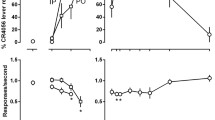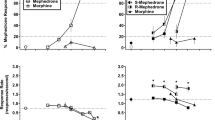Abstract
The influence of several α2-adrenergic agents on the discriminative stimulus (DS) properties of lysergic acid diethylamide (LSD) was studied in rats trained to discriminate 0.08 mg/kg (186 nmol/kg) of LSD from saline in a two-lever operant paradigm. Only yohimbine fully mimicked LSD with an ED50 of 2.05 mg/kg (5.24 µmol/kg). Yohimbine's 5-HT1A agonist properties may be responsible for this substitution. Other α2-adrenoceptor antagonists, idazoxan with an agonist/antagonist profile at 5-HT1A receptors and RS 26026-197, a highly selective α2-adrenoceptor antagonist, failed to produce substitution. Clonidine, an α2-adrenoceptor agonist, did not substitute for LSD but the response rate was dose-dependently reduced. None of the α2-adrenergic agents used for pretreatment before LSD inhibited the response to the LSD training dose. Coadministration of clonidine with LSD produced a leftward shift of the dose-response relationship of LSD without a significant change in the slope of the dose-response line. Simultaneous administration of α2-adrenergic agents with LSD shifted the dose-response curve to the left only when the adrenergic agent also possessed at least moderate affinity for the 5-HT1A receptor. In addition, radioligand competition experiments were performed that showed LSD to have relatively high affinity (Ki=37 nM) for [3H]clonidine-labeled sites in rat cortex with lower affinity for [3H]yohimbine labeled sites. While previous studies have suggested that the nature of the LSD cue may be essentially expressed by 5-HT2 receptor activation, the present data show that this cue can be modulated by effects of LSD at 5-HT1A and at other monoamine neurotransmitter receptors.
Similar content being viewed by others
References
Appel JB, Cunningham KA (1986) The use of drug discrimination procedures to characterize hallucinogenic drug actions. Psychopharmacol Bull 22: 959–967
Arnt J (1989) Characterization of the discriminative stimulus properties induced by 5-HT1 and 5-HT2 agonists in rats. Pharmacol Toxicol 64: 165–172
Aulakh CS, Hill JL, Lesh KP, Murphy DL (1992) Functional subsensitivity of 5-hydroxytryptamine1C or alpha2 adrenergic heteroreceptors mediating clonidine-induced growth hormone release in the Fawn-Hooded rat strain relative to the Wistar rat strain. J Pharmacol Exp Ther 262: 1038–1043
Backus LI, Sharp T, Grahame-Smith DG (1990) Behavioural evidence for a functional interaction between central 5-HT2 and 5-HT1A receptors. Br J Pharmacol 100: 793–799
Berendsen HHG, Broekkamp CLE (1990) Behavioural evidence for functional interactions between 5-HT receptor subtypes in rats and mice. Br J Pharmacol 101: 667–673
Broadhurst AM, Alexander BS, Wood MD (1988) Heterogenous3H-rauwolscine binding sites in rat cortex: two alpha2-adrenoceptor subtypes or an additional non-adrenergic interaction. Life Sci 43: 83–92
Clark RD, Repke DB, Berger J, Nelson JT, Kilpatrick AT, Brown CM, MacKinnon AC, Clague RU, Spedding M (1991) Structure-affinity relationships of 12-sulfonyl derivatives of 5,8,8a,9,10,11,12,12a,13,13a-decahydro-6H-isoquino[2, 1-g] [1, 6] naphthyridines at α-adrenoceptors. J Med Chem 34: 705–717
Clement HH, Gesma D, Wesemann W (1992) The effect of adrenergic drugs on serotonin metabolism in the nucleus raphe dorsalis of the rat, studied in vivo voltametry. Eur J Pharmacol 217: 43–49
Colpaert FC (1984) Cross generalization with LSD and yohimbine in the rat. Eur J Pharmacol 102: 73–77
Colpaert FC, Niemegeers CJE, Janssen PAJ (1979) In vivo evidence of partial agonist activity exerted by purported 5-hydroxytryptamine antagonists. Eur J Pharmacol 58: 505–509
Colpaert FC, Niemegeers CJE, Janssen PAJ (1982) A drug discrimination analysis of lysergic acid diethylamide (LSD): in vivo agonist and antagonist effects of purported 5-hydroxytryptamine antagonists and of pirenperone, a LSD-antagonist. J Pharmacol Exp Ther 221: 206–214
Creese I, Burt DR, Snyder SH (1975) The dopamine receptor: differential binding of d-LSD and related agents to agonist and antagonist states. Life Sci 17: 1715–1719
Cunningham KA, Appel JB (1987) Neuropharmacological reassessment of the discriminative stimulus properties ofd-lysergic acid diethylamide (LSD) Psychopharmacology 91: 67–73
Darmani NR, Martin BR, Pandey U, Glennon RA (1990) Do functional relationships exist between 5-HT1A and 5-HT2 receptors? Pharmacol Biochem Behav 36: 901–906
Done CJG, Sharp T (1992) Evidence that 5-HT2 receptor activation decreases noradrenaline release in rat hippocampus in vivo. Br J Pharmacol 107: 240–245
Extance K, Goudie AJ (1981) Inter-animal olfactory cues in operant drug discrimination procedures in rats. Psychopharmacology 73: 363–368
Fozard JR, Mir AK, Middlemiss DN (1987) The cardiovascular response to 8-hydroxy-2-di-n-propylamino) tetralin (8-OH-DPAT) in the rat: site of action and pharmacological analysis. J Cardiovasc Pharmacol 9: 328–331
Friedman RL, Barrett RJ, Sanders-Bush E (1984) Discriminative stimulus properties of guipazine: mediation by serotonin2 binding sites. J Pharmacol Exp Ther 228: 628–635
Geyer MA, Lee EHY (1984) Effects of clonidine, piperoxane and locus coeruleus lesion on the serotonergic and dopaminergic systems in rhaphe and caudate nucleus. Biochem Pharmacol 33: 3399–3404
Glennon RA (1990) Do classical hallucinogens act as 5-HT2 agonist or antagonist? Neuropsychopharmacology 3: 509–517
Glennon RA, Titeler M, McKenney JD (1984) Evidence for 5-HT2 involvement in the mechanism of action of hallucinogenic agents. Life Sci 35: 2505–2511
Holohean AM, White FJ, Appel JB (1982) Dopaminergic and serotonergic mediation of the discriminable effects of ergot alkaloids. Eur J Pharmacol 81: 595–602
Hoyer D (1988) Functional correlates of serotonin 5-HT1 recognition sites. J Recept Res 8: 59–81
Hoyer D, Schoeffter P (1991) 5-HT receptors and second messengers. J Recept Res 11: 1–4
Huang X, Marona-Lewicka D, Pfaff RC, Nichols DE (1994) Drug discrimination and receptor binding studies ofN-isopropyl lysergamide derivatives. Pharmacol Biochem Behav 47: 667–673
Ireland SJ, Tyers MB (1987) Pharmacological characterization of 5-hydroxytryptamine-induced depolarization of the rat isolated vagus nerve. Br J Pharmacol 90: 229–238
Jhanwar-Uniyal M, Moorjani B, Kahn AH (1994) Indications of pre- and post-synaptic 5-HT1A receptor interactions in feeding behavior and neuroendocrine regulation. Brain Res 646: 247–257
Kawai N, Yamamoto T, Baba A, Yamamoto H, Moroji T (1994) Inhibitory effect of idazoxan on forskolin stimulated adenylate cyclase activity through 5-hydroxytryptamine1A receptors. Arzneimittelforschung 44: 1–3
Kuhn DM, White FJ, Appel JB (1977) Discriminative stimulus properties of hallucinogens: behavioral assay of drug action. In: Lal H (ed) Discriminative stimulus properties of drugs. Plenum Press, New York, pp 137–154
Kuhn DM, White FJ, Appel JB (1978) The discriminative stimulus properties of LSD: mechanism of action. Neuropharmacology 17: 257–263
Langer SZ, Moret C (1982) Citalopram antagonizes the stimulation by lysergic acid diethylamide of presynaptic inhibitory autoreceptors in the rat hypothalamus. J Pharmacol Exp Ther 222: 220–226
Levine RR (1990) The log dose-effect curve. Pharmacology: drug actions and reactions, 4th edn. Little, Brown, Boston, pp 187–190
Leysen JE, Niemegeers CJE, Van Nueten JM, Laduron PM (1982) [3H]Ketanserin (R41 468), a selective3H-ligand for serotonin2 receptor binding sites. Mol Pharmacol 21: 301–314
Litchfield JT, Wilcoxon FA (1949) A simplified method of evaluating dose-effect experiments. J Pharmacol Exp Ther 96: 99–113
Marona-Lewicka D, Nichols DE (1994) Behavioral effects of the highly selective serotonin releasing agent 5-methoxy-6-methyl-2-aminoindan. Eur J Pharmacol 258: 1–13
Marsden CA, Martin KF (1986) Involvement of 5-HT1A- and α2-receptors in the decreased 5-hydroxytryptamine release and metabolism in rat suprachiasmatic nucleus after intravenous 8-hydroxy-2-(n-dipropylamino) tetralin. Br J Pharmacol 89 277–286
Maura G, Gemignani A, Raiteri M (1985) α2-Adenoceptors in rat hypothalamus and cerebral cortex: evidence of pharmacological distinct subpopulations. Eur J Pharmacol 116: 335–339
Meert TF, De Haes PLAJ, Vermote PCM (1990) The discriminative stimulus properties of LSD: serotonergic and catecholaminergic interactions. Psychopharmacology 101: S71(271)
McCall RB, Harris LT, King KA (1991) Sympatholytic action of yohimbine mediated by 5-HT1A receptors. Eur J Pharmacol 199: 263–265
Michel MC, Regan JW, Gerhardt MA, Neubig RR, Motulsky HJ (1990) Noradrenergic [3H]idazoxan binding sites are physically distinct from alpha2-adrenergic receptors. Mol Pharmacol 37: 65–68
Mokler DJ, Commissaris RL, Warner MR, Rech RH (1983) Blockade of the behavioral effects of lysergic acid diethylamide, 2,5-dimethoxy-4-methylamphetamine, quipazine and lisuride by 5-hydroxytryptamine antagonists. J Pharmacol Exp Ther 22: 557–562
Mongeau R, Blier P, de Montigny C (1993) In vivo electrophysiological evidence for tonic activation by endogenous noradrenaline of α2-adrenoceptors on 5-hydroxytryptamine terminals in the rat hippocampus. Naunyn-Schmiedeberg's Arch Pharmacol 347: 266–272
Mongeau R, de Montigny C, Blier P (1994) Electrophysiologic evidence for desensitization of α2-adrenoceptors on serotonin terminals following long-term treatment with drugs increasing norepinephrine synaptic concentration. Neuropsychopharmacology 10: 41–51
Oberlender R, Nichols DE (1988) Drug discrimination studies with MDMA and amphetamine. Psychopharmacology 95: 71–76
Oberlender R, Nichols DE (1990) (+)-N-Methyl-1-(1,3-benzodioxol-5-yl)-2-butanamine as a discriminative stimulus in studies of 3,4-methylenedioxymethamphetamine-like behavioral activity. J Pharmacol Exp Ther 255: 1098–1104
Pierce PA, Peroutka SJ (1989) Hallucinogenic drug interactions with neurotransmitter receptor binding sites in human cortex. Psychopharmacology 97: 118–122
Pierce PA, Peroutka SJ (1990) Antagonist properties ofd-LSD at 5-hydroxytryptamine2 receptors. Neuropsychopharmacology 3: 503–508
Raiteri M, Maura G, Versace P (1983) Functional evidence for two stereochemically different alpha2-adrenoceptors regulating noradrenaline and serotonin release. J Pharmacol Exp Ther 224: 679–684
Rogawski MA, Aghajanian GK (1979) Response of central monoaminergic neurones to lisuride: comparison with LSD. Life Sci 24: 1289–1298
Schoeffter P, Hoyer D (1991) Interaction of the α2-adrenoceptor agonist oxymetazoline with serotonin 5-HT1A 5-HT1B, 5-HT1C and 5-HT1D receptors. Eur J Pharmacol 96: 213–216
Svensson T, Bunney TB, Aghajanian G (1975) Inhibition of both noradrenergic and serotonergic neurons in brain by the α-adrenergic agonist clonidine. Brain Res 91: 291–297
Thoolen MJMC, Timmermans PBMWM, Van Zwieten PA (1983) Cardiovascular effects of withdrawal of some centrally acting antihyperthensive drugs in the rat. Br J Clin Pharmacol 15: 491S-505S
Titeler M, Lyon RA, Glennon RA (1988) Radioligand binding evidence implicates the brain 5-HT2 receptor as a site of action for LSD and phenylisopropylamine halucinogens. Psychopharmacology 94: 213–216
Van Wijngaarden I, Tulp MThM, Soudjin W (1990) The concept of selectivity in 5-HT receptor research. Eur J Pharmacol 188: 301–312
Walker EA, Yamamoto T, Hollingsworth PJ, Smith CB, Woods JH (1991) Discriminative -stimulus effects of quipazine and 1-5-hydroxytryptophan in relation to serotonin binding sites in the pigeons. J Pharmacol Exp Ther 259: 772–782
White FJ, Kuhn DM, Appel JB (1977) Discriminative stimulus properties of quipazine. Neuropharmacology 16: 827–832
White FJ, Simmons MA, West KB, Holohean AM, Appel JB (1980) The effect of serotonin depletion on the discriminability of LSD. Pharmacol Biochem Behav 13: 569–574
Winter JC (1978) Yohimbine-induced stimulus control in the rat. Arch Int Pharmacodyn Ther 235: 86–92
Winter JC (1988) Generalization of the discriminative stimulus properties of 8-hydroxy-2-(di-n-propylamino)tetralin (8-OH-DPAT) and ipsapirone to yohimbine. Pharmacol Biochem Behav 29: 193–195
Winter JC, Rabin RA (1988) Interactions between serotonergic agonist and antagonists in rats trained with LSD as a discriminative stimulus. Pharmacol Biochem Behav 30: 617–624
Winter JC, Rabin RA (1989) Yohimbine and serotonergic agonists: stimulus properties and receptor binding. Drug Dev Res 16: 327–333
Winter JC, Rabin RA (1992) Yohimbine as a serotonergic agent: evidence from receptor binding and drug discrimination. J Pharmacol Exp Ther 263: 682–689
Winter JC, Rabin RA (1993) Antagonism of the stimulus effects of yohimbine and 8-hydroxydipropylaminotetralin. Pharmacol Biochem Behav 44: 851–855
Yamamoto T, Walker EA, Woods JH (1991) Agonist and antagonist properties of serotonergic compounds in pigeons trained to discriminate either quipazine or 1-5-hydroxytryptophan. J Pharmacol Exp Ther 258: 999–1007
Ybema CY, Oliver B, Mos J, Tulp MTM, Slangen JL (1994) Adrenoceptors and dopamine receptors are not involved in the discriminative stimulus effect of the 5-HT1A receptor agonist flesinoxan. Eur J Pharmacol 256: 141–147
Yocca FD, Wright RN, Margraf RR, Eison AS (1990) 8-OH-DPAT and buspirone analogs inhibit the ketanserin-sensitive quipazine-induced head shakes response in rats. Pharmacol Biochem Behav 35: 251–254
Author information
Authors and Affiliations
Rights and permissions
About this article
Cite this article
Marona-Lewicka, D., Nichols, D.E. Complex stimulus properties of LSD: a drug discrimination study with α2-adrenoceptor agonists and antagonists. Psychopharmacology 120, 384–391 (1995). https://doi.org/10.1007/BF02245809
Received:
Revised:
Issue Date:
DOI: https://doi.org/10.1007/BF02245809




